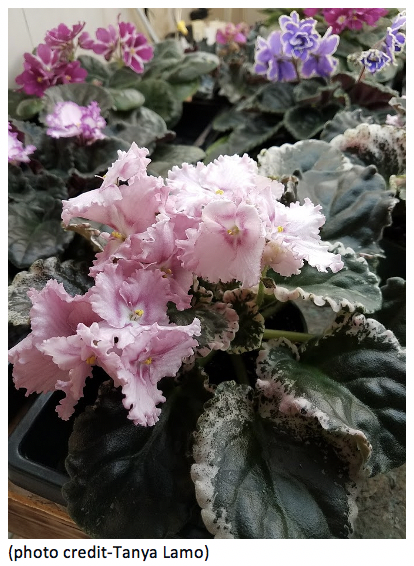African Violets Part 1 – Growing Tips
go.ncsu.edu/readext?756104
en Español / em Português
El inglés es el idioma de control de esta página. En la medida en que haya algún conflicto entre la traducción al inglés y la traducción, el inglés prevalece.
Al hacer clic en el enlace de traducción se activa un servicio de traducción gratuito para convertir la página al español. Al igual que con cualquier traducción por Internet, la conversión no es sensible al contexto y puede que no traduzca el texto en su significado original. NC State Extension no garantiza la exactitud del texto traducido. Por favor, tenga en cuenta que algunas aplicaciones y/o servicios pueden no funcionar como se espera cuando se traducen.
Português
Inglês é o idioma de controle desta página. Na medida que haja algum conflito entre o texto original em Inglês e a tradução, o Inglês prevalece.
Ao clicar no link de tradução, um serviço gratuito de tradução será ativado para converter a página para o Português. Como em qualquer tradução pela internet, a conversão não é sensivel ao contexto e pode não ocorrer a tradução para o significado orginal. O serviço de Extensão da Carolina do Norte (NC State Extension) não garante a exatidão do texto traduzido. Por favor, observe que algumas funções ou serviços podem não funcionar como esperado após a tradução.
English
English is the controlling language of this page. To the extent there is any conflict between the English text and the translation, English controls.
Clicking on the translation link activates a free translation service to convert the page to Spanish. As with any Internet translation, the conversion is not context-sensitive and may not translate the text to its original meaning. NC State Extension does not guarantee the accuracy of the translated text. Please note that some applications and/or services may not function as expected when translated.
Collapse ▲The African Violet, genus Saintpaulia, are part of the Gesneriad family. First discovered and documented in Tanzania, they were brought to the United States in 1894. These plants have a history of being a popular houseplant. Many people may have tried their hand at raising one of these beauties, or they may have inherited one from a beloved family member. Today, there are many varieties available to collect that can create a unique and rewarding hobby.
For many years, my family and I owned a business called The Violet Rainbow. For this business, we propagated and raised over 8,000 African Violets annually to sell at the Philadelphia Flower Show. We had our share of questions about the proper care for African Violets. Below are a few tips and pointers that can help keep your plant happy, healthy, and blooming.
- Light. Morning sun. African Violets thrive in bright, indirect light. This often is sourced in windows that face east. Many people also have success growing them under fluorescent lighting with 10-12 hours of exposure. Light is key to keeping violets thriving and blooming.
- Water. African Violets do not like wet feet! Only water every 7 to 10 days or when they are dry to the touch. It is better to keep them too dry rather than too wet, this is because they have a shallow root system and are susceptible to root rot. Signs of overwatering can resemble wilted leaves, but if the soil is still damp, do not water.
- Temperature. African Violets are comfortable in the same temperatures we enjoy. If you are growing them in a window and it gets too cool in the winter, it can cause leaf damage that will resemble soft, mushy leaves. If this happens, remove damaged leaves, and set away from the cool location.
- Fertilizer. For the best foliage growth and most consistent blooms, it is recommended to use a dilute solution of fertilizer of ¼ tsp per gallon every time you water. A fertilizer that is relatively balanced with nitrogen-phosphorous-potassium is best. Mix up a gallon and treat your plants each week.
- Soil. Plant African Violets in light soil that has good drainage. If soil remains wet for too long, it will cause root rot. Soilless, peat-based mixtures that contain perlite and vermiculite can help keep your violet healthy.
- Disbudding. If you have success getting your African Violet to bloom, be sure to pinch or deadhead spent blooms. This process allows the plant to continue to put energy into creating more buds/blooms and beautiful foliage.
- As African Violets age, the lower leaves begin to fall off the plant. Over time, this can create a “neck” and cause your plant to be unstable and unsightly. It is good practice to transplant your violet once a year. They should be planted in a pot that is 1/3rd the size of the leaf span. If you have a 12-inch leaf span, you should be using a 4-inch pot. Again, their shallow root systems enjoy being more confined. If they are in a pot that is too large, they will not bloom as frequently. Be sure to keep the soil loose and not packed too tightly to allow for good drainage.
If you have success growing these beautiful plants, keep doing what you are doing. If you haven’t attempted growing an African Violet, I would encourage you to try adding one of these plants to your collection, you may find it to be very rewarding.
Next month, I will cover how to easily propagate African Violets with a leaf cutting.





